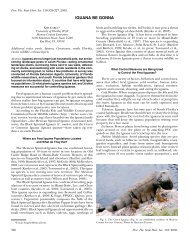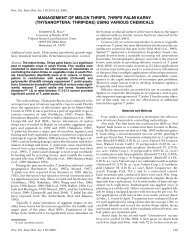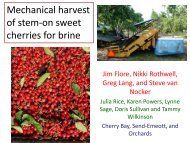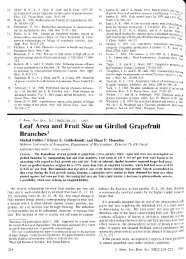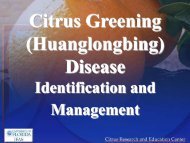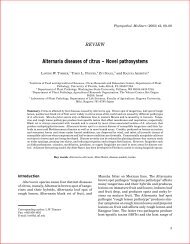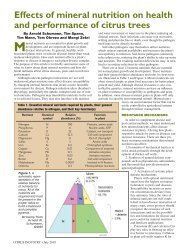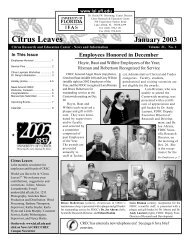Ultrastructural Studies on the Ontogeny of Grapefruit Juice Vesicles ...
Ultrastructural Studies on the Ontogeny of Grapefruit Juice Vesicles ...
Ultrastructural Studies on the Ontogeny of Grapefruit Juice Vesicles ...
Create successful ePaper yourself
Turn your PDF publications into a flip-book with our unique Google optimized e-Paper software.
<str<strong>on</strong>g>Ultrastructural</str<strong>on</strong>g> <str<strong>on</strong>g>Studies</str<strong>on</strong>g> <strong>on</strong> <strong>the</strong> <strong>Ontogeny</strong> <strong>of</strong> <strong>Grapefruit</strong> <strong>Juice</strong> <strong>Vesicles</strong> (Citrus paradisi Macf.<br />
CV Star Ruby)<br />
Author(s): Jacqueline K. Burns, Diann S. Achor, Ed Echeverria<br />
Reviewed work(s):<br />
Source: Internati<strong>on</strong>al Journal <strong>of</strong> Plant Sciences, Vol. 153, No. 1 (Mar., 1992), pp. 14-25<br />
Published by: The University <strong>of</strong> Chicago Press<br />
Stable URL: http://www.jstor.org/stable/2995700 .<br />
Accessed: 07/03/2012 11:17<br />
Your use <strong>of</strong> <strong>the</strong> JSTOR archive indicates your acceptance <strong>of</strong> <strong>the</strong> Terms & C<strong>on</strong>diti<strong>on</strong>s <strong>of</strong> Use, available at .<br />
http://www.jstor.org/page/info/about/policies/terms.jsp<br />
JSTOR is a not-for-pr<strong>of</strong>it service that helps scholars, researchers, and students discover, use, and build up<strong>on</strong> a wide range <strong>of</strong><br />
c<strong>on</strong>tent in a trusted digital archive. We use informati<strong>on</strong> technology and tools to increase productivity and facilitate new forms<br />
<strong>of</strong> scholarship. For more informati<strong>on</strong> about JSTOR, please c<strong>on</strong>tact support@jstor.org.<br />
http://www.jstor.org<br />
The University <strong>of</strong> Chicago Press is collaborating with JSTOR to digitize, preserve and extend access to<br />
Internati<strong>on</strong>al Journal <strong>of</strong> Plant Sciences.
Int. J. Plant Sci. 153(l):14-25. 1992<br />
? 1992 by The University <strong>of</strong> Chicago. All rights reserved.<br />
1058-5893/92/5301 -0004$02.00<br />
ULTRASTRUCTURAL STUDIES ON THE ONTOGENY OF GRAPEFRUIT<br />
JUICE VESICLES (CITRUS PARADISI MACF. CV STAR RUBY)'<br />
JACQUELINE K. BURNS, DIANN S. ACHOR, AND ED ECHEVERRIA<br />
Citrus Research and Educati<strong>on</strong> Center, University <strong>of</strong> Florida, IFAS, Lake Alfred, Florida 33850<br />
The ultrastructure <strong>of</strong> juice vesicle development and maturati<strong>on</strong> was investigated in cv Star Ruby<br />
grapefruit. <strong>Juice</strong> vesicle primordia were initiated by divisi<strong>on</strong>s <strong>of</strong> epidermal and subepidermal cells <strong>on</strong> <strong>the</strong><br />
adaxial surface <strong>of</strong> <strong>the</strong> carpel wall at least 2 d before an<strong>the</strong>sis. Development occurred in three distinct<br />
stages: cell divisi<strong>on</strong>, cell el<strong>on</strong>gati<strong>on</strong>, and cell maturati<strong>on</strong>. Development <strong>of</strong> juice vesicles in <strong>the</strong> first 3 wk<br />
postan<strong>the</strong>sis occurred by cell divisi<strong>on</strong> <strong>of</strong> a subterminal meristem and resulted in <strong>the</strong> formati<strong>on</strong> <strong>of</strong> a main<br />
juice vesicle body subtended by highly vacuolate stalk cells c<strong>on</strong>nected to <strong>the</strong> carpel wall. Cells <strong>of</strong> <strong>the</strong> main<br />
body were characteristic <strong>of</strong> meristematic cells. Between 4 and 10 wk postan<strong>the</strong>sis, oil gland/oil cavity<br />
development occurred in <strong>the</strong> center <strong>of</strong> <strong>the</strong> main juice vesicle body and began with a single electr<strong>on</strong>-dense<br />
cell. Surrounding cells exhibited characteristics <strong>of</strong> intense metabolic and secretory activity, culminating<br />
in <strong>the</strong> syn<strong>the</strong>sis <strong>of</strong> lipid and osmiophilic material. A schizogenous and/or lysigenous cavity developed in<br />
<strong>the</strong> central area <strong>of</strong> <strong>the</strong> main juice vesicle body, where fibrillar-oil material and lysed cell remnants were<br />
observed, respectively. Expansi<strong>on</strong> <strong>of</strong> surrounding cells resulted in fur<strong>the</strong>r lysigeny <strong>of</strong> <strong>the</strong> central electr<strong>on</strong>dense<br />
cells. The mature juice vesicle body c<strong>on</strong>tained highly vacuolate central cells surrounded by a<br />
hypodermis and epidermal layer. The central cavity remained even after 12 mo <strong>of</strong> juice vesicle develoDment.<br />
Introducti<strong>on</strong><br />
<strong>Juice</strong> vesicle development, as in whole citrus<br />
fruit, can be divided into three distinct but overlapping<br />
stages: cell divisi<strong>on</strong>, cell el<strong>on</strong>gati<strong>on</strong>, and<br />
cell maturati<strong>on</strong> (Ford 1942; Bain 1958; Schneider<br />
1968; Nii and Coombe 1988). The cell divisi<strong>on</strong><br />
stage is characterized by juice vesicle initiati<strong>on</strong><br />
at or before an<strong>the</strong>sis al<strong>on</strong>g <strong>the</strong> adaxial surface <strong>of</strong><br />
<strong>the</strong> endocarp wall. <strong>Juice</strong> vesicles arise as a result<br />
<strong>of</strong> anticlinal and <strong>the</strong>n periclinal divisi<strong>on</strong>s <strong>of</strong> epidermal<br />
and subepidermal cells <strong>of</strong> <strong>the</strong> endocarp.<br />
Cell divisi<strong>on</strong>s <strong>of</strong> a subterminal juice vesicle primordia<br />
meristem c<strong>on</strong>tinue until <strong>the</strong> juice vesicles,<br />
with main body c<strong>on</strong>nected to <strong>the</strong> segment<br />
wall by a multicellular stalk, fill at least <strong>on</strong>e-half<br />
<strong>of</strong> <strong>the</strong> segment space. The rate <strong>of</strong> cell divisi<strong>on</strong><br />
decreases as <strong>the</strong> cell enlargement phase commences,<br />
resulting in complete fill <strong>of</strong> <strong>the</strong> segment<br />
space. At <strong>the</strong> initiati<strong>on</strong> <strong>of</strong> cell maturati<strong>on</strong>, el<strong>on</strong>gati<strong>on</strong><br />
ceases, soluble solids accumulate, and total<br />
acid declines. The entire juice vesicle is c<strong>on</strong>tained<br />
within an epidermis covered with a defined cuticle<br />
(Fahn et al. 1974; Espelie et al. 1980). <strong>Juice</strong><br />
vesicles may c<strong>on</strong>tain a small lipid deposit within<br />
<strong>the</strong> main body at various stages <strong>of</strong> development.<br />
Little chr<strong>on</strong>ological ultrastructural detail is<br />
available <strong>on</strong> <strong>the</strong> growth, development, and maturati<strong>on</strong><br />
<strong>of</strong> juice vesicles. In this report, we pro-<br />
' Florida Agricultural Experiment Stati<strong>on</strong> Journal Series no.<br />
R-0 1759.<br />
Manuscript receivedAugust 1991; revised manuscript received<br />
September 1991.<br />
Address for corresp<strong>on</strong>dence and reprints: Jacqueline K.<br />
Bums, Citrus Research and Educati<strong>on</strong> Center, University <strong>of</strong><br />
Florida, IFAS, 700 Experiment Stati<strong>on</strong> Road, Lake Alfred,<br />
Florida 33850.<br />
14<br />
vide anatomical and ultrastructural detail with<br />
<strong>the</strong> use <strong>of</strong> light, scanning, and transmissi<strong>on</strong> electr<strong>on</strong><br />
microscopy <strong>on</strong> <strong>the</strong> initiati<strong>on</strong>, growth, and<br />
maturati<strong>on</strong> <strong>of</strong> grapefruit juice vesicles during 12<br />
mo <strong>of</strong> development. In additi<strong>on</strong>, we describe <strong>the</strong><br />
development <strong>of</strong> <strong>the</strong> lipid deposit in <strong>the</strong> main body<br />
<strong>of</strong> <strong>the</strong> juice vesicle.<br />
Material and methods<br />
PLANT MATERIAL<br />
Flowers, fruitlets, and fruit <strong>of</strong> cv Star Ruby<br />
grapefruit (Citrus paradisi Macf.) were collected<br />
from a single tree at <strong>the</strong> Citrus Arboretum, Flor-<br />
ida Department <strong>of</strong> Agriculture, Winter Haven. In<br />
February 1990, at least six flower buds were col-<br />
lected 2 d prior to and at an<strong>the</strong>sis. Additi<strong>on</strong>al<br />
flowers were tagged at an<strong>the</strong>sis, and at least six<br />
fruitlets or fruits were collected at various times<br />
postan<strong>the</strong>sis for up to 12 mo. Organs were brought<br />
to <strong>the</strong> laboratory and weighed, and measure-<br />
ments <strong>of</strong> distance were taken from stem to stylar<br />
end and <strong>of</strong> <strong>the</strong> equatorial diameter. Whole ova-<br />
ries or fruitlets were utilized for microscope stud-<br />
ies for <strong>the</strong> first 28 d <strong>of</strong> development, after which<br />
individual juice vesicles were excised and utilized<br />
for fur<strong>the</strong>r study.<br />
SCANNING ELECTRON MICROSCOPY<br />
Whole ovaries and fruitlets were observed with<br />
<strong>the</strong> scanning electr<strong>on</strong> microscope. Using a razor<br />
blade, l<strong>on</strong>gitudinal secti<strong>on</strong>s were made through<br />
<strong>the</strong> organs. The tissue was fixed in 3% glutaraldehyde<br />
in 0.2 M K2HPO4 (pH 7.0) for 3-4 h at<br />
ambient temperature, followed by postfixati<strong>on</strong> in<br />
buffered 2% OSO4 for 2 h as described by Bums<br />
and Achor (1989). After dehydrati<strong>on</strong> in an ethanol<br />
series, <strong>the</strong> tissue was critical point dried,<br />
sputter-coated with gold, and viewed with a Hi-
400<br />
350<br />
BURNS ET AL.-JUICE VESICLE DEVELOPMENT AND MATURATION 15<br />
0<br />
? fresh weight .350 0<br />
a diameter /.<br />
300 A length 300<br />
250 2 250<br />
c- 0<br />
200 - 200<br />
400<br />
150 -<br />
1503<br />
e ~~~~~~~~~~~~~~~~~~~~~~~~~~~~~~~~CD<br />
100 5-<br />
10<br />
50 - 50 3<br />
o<br />
3<br />
0<br />
10<br />
0 50 100 150 200 250 300<br />
Days from an<strong>the</strong>sis<br />
Fig. I Fruit fresh weight, length, and diameter <strong>of</strong> cv Star<br />
Ruby grapefruit from an<strong>the</strong>sis to 300 d <strong>of</strong> fruit development.<br />
Data plotted are <strong>the</strong> means <strong>of</strong> at least six fruitlets or fruit,<br />
with error bars indicating standard deviati<strong>on</strong>.<br />
tachi S530 scanning electr<strong>on</strong> microscope at 20<br />
kV.<br />
LIGHT AND TRANSMISSION<br />
ELECTRON MICROSCOPY<br />
Whole ovaries, fruitlets, and juice vesicles were<br />
used for light microscopy and transmissi<strong>on</strong> elec-<br />
tr<strong>on</strong> microscopy. L<strong>on</strong>gitudinal or cross-secti<strong>on</strong>s<br />
were made with a razor blade through young ova-<br />
ries or fruitlets, and fixati<strong>on</strong> and postfixati<strong>on</strong> were<br />
performed as described above. In some cases,<br />
especially later in fruit development, l<strong>on</strong>gitudinal<br />
and cross-secti<strong>on</strong>s were made through intact juice<br />
vesicles after fixati<strong>on</strong> but before postfixati<strong>on</strong>. Af-<br />
ter dehydrati<strong>on</strong> in an ethanol series, <strong>the</strong> tissue<br />
was polymerized in L. R. White or Spurr's resin<br />
(Spurr 1969) overnight at 60 C or at 70 C for 24<br />
h, respectively. Thick secti<strong>on</strong>s (1 Mm) were cut<br />
with a microtome and stained with methylene<br />
blue-azure A/basic fuchsin. The secti<strong>on</strong>s were<br />
mounted and viewed with an Olympus BH-2 light<br />
microscope. Thin secti<strong>on</strong>s (0.1 Mm) were cut and<br />
stained with 4% aqueous or methanolic uranyl<br />
acetate for 15 min and poststained with 0. 5% lead<br />
citrate for 5 min (Stempak and Ward 1964). The<br />
secti<strong>on</strong>s were <strong>the</strong>n viewed with a Philips 201<br />
transmissi<strong>on</strong> electr<strong>on</strong> microscope at 60 kV.<br />
Results<br />
FRUIT GROWTH<br />
Fresh weight <strong>of</strong> grapefruit fruit followed a typical<br />
sigmoidal growth curve during <strong>the</strong> 300 d <strong>of</strong><br />
study (fig. 1). Three growth stages could be distinguished<br />
in fruit <strong>of</strong> Star Ruby grapefruit. Stages<br />
1, 2, and 3 were approximately 8 wk, 10-22 wk,<br />
and equal to or greater than 23 wk postan<strong>the</strong>sis,<br />
respectively. Trends in fruit length and diameter<br />
were similar throughout <strong>the</strong> sampling period. Both<br />
length and diameter increased in a linear fashi<strong>on</strong><br />
for <strong>the</strong> first 150 d postan<strong>the</strong>sis, after which no<br />
fur<strong>the</strong>r increases were measured.<br />
JUICE VESICLE INITIATION AND EARLY GROWTH<br />
<strong>Juice</strong> vesicles initially appeared as small elevated<br />
areas and were initiated at least 2 d prior<br />
to an<strong>the</strong>sis al<strong>on</strong>g <strong>the</strong> adaxial surface <strong>of</strong> <strong>the</strong> carpel<br />
wall (figs. 2, 3). <strong>Juice</strong> vesicles originated from<br />
divisi<strong>on</strong>s <strong>of</strong> epidermal and subepidermal cells (fig.<br />
4). The meristematic cells were densely cytoplasmic<br />
and, in c<strong>on</strong>trast to cells <strong>of</strong> <strong>the</strong> ovary wall,<br />
lacked well-formed, large central vacuoles. <strong>Juice</strong><br />
vesicle primordia c<strong>on</strong>tinued to increase in size<br />
(fig. 5), and divisi<strong>on</strong>s c<strong>on</strong>tinued to occur 3 d postan<strong>the</strong>sis<br />
in <strong>the</strong> juice vesicle initials (figs. 6, 7). By<br />
10 d postan<strong>the</strong>sis, highly vacuolated stalk cells<br />
were differentiated and subtended <strong>the</strong> meristematic<br />
regi<strong>on</strong> <strong>of</strong> <strong>the</strong> juice vesicle (figs. 8-10). As<br />
divisi<strong>on</strong>s c<strong>on</strong>tinued, carpellary outgrowths and<br />
developing juice vesicles, each distinctly different,<br />
were scattered throughout <strong>the</strong> surface <strong>of</strong> <strong>the</strong><br />
carpel wall (figs. 6, 8). Carpellary outgrowths, visible<br />
3 d after full bloom (figs. 5, 6), had a welldefined<br />
stalk regi<strong>on</strong> after 10 d postan<strong>the</strong>sis (fig.<br />
9). The terminal regi<strong>on</strong> <strong>of</strong> <strong>the</strong> carpellary outgrowth<br />
c<strong>on</strong>tained greatly enlarged cells which<br />
c<strong>on</strong>tinued to divide. Intercellular spaces <strong>of</strong> <strong>the</strong><br />
carpellary outgrowths were also filled <strong>on</strong> occasi<strong>on</strong><br />
with darkly staining material, apparently produced<br />
by <strong>the</strong> large globose cells.<br />
<strong>Juice</strong> vesicles c<strong>on</strong>tinued to el<strong>on</strong>gate and fill <strong>the</strong><br />
segment space after 3 wk postan<strong>the</strong>sis (fig. 1 1).<br />
Carpellary outgrowths remained a prominent feature.<br />
Light and transmissi<strong>on</strong> electr<strong>on</strong> micrographs<br />
revealed that stalk cells c<strong>on</strong>tinued to differentiate,<br />
while <strong>the</strong> main body <strong>of</strong> <strong>the</strong> juice vesicle<br />
remained meristematic (figs. 12, 13). Meriste-<br />
Figs. 2-7 <strong>Juice</strong> vesicle development 2 d before and 3 d after an<strong>the</strong>sis in grapefruit. Fig. 2, Scanning electr<strong>on</strong> micrograph <strong>of</strong><br />
juice vesicle initiati<strong>on</strong> al<strong>on</strong>g <strong>the</strong> carpel wall 2 d prior to an<strong>the</strong>sis, in l<strong>on</strong>gitudinal secti<strong>on</strong>. Fig. 3, Light micrograph <strong>of</strong> juice<br />
vesicle initiati<strong>on</strong> 2 d before an<strong>the</strong>sis. Fig. 4, Transmissi<strong>on</strong> electr<strong>on</strong> micrograph <strong>of</strong> a juice vesicle primordium 2 d before an<strong>the</strong>sis.<br />
Fig. 5, Scanning micrograph <strong>of</strong> juice vesicles and carpellary outgrowths 3 d postan<strong>the</strong>sis. Fig. 6, Light micrograph <strong>of</strong> juice<br />
vesicles and carpellary outgrowths 3 d postan<strong>the</strong>sis. Fig. 7, Transmissi<strong>on</strong> micrograph <strong>of</strong>juice vesicle 3 d postan<strong>the</strong>sis. ce, carpel<br />
epidermis; co, carpellary outgrowth; eh, epidermal hairs; jvp, juice vesicle primordium; ow, ovary wall; s, seed; vt, vascular<br />
tissue.<br />
---4
4d , 7p<br />
if<br />
- ~~~~~~~~~~~~~~~ '9*<br />
A - ~ , _ _ _ _ _ _ _ _ _ _ _<br />
5IJ'<br />
16<br />
16~~~~~~~~~~~~~~~~~~~~~~~1
z<br />
"_ .t * _<br />
0** 0''&J % 't2 *- 4'>?t?4t *1<br />
r ~~~~~~~~~~~~~~~~~~~~4<br />
Figs.<br />
8-13 <strong>Juice</strong> vesicle development 10 and 21 d postan<strong>the</strong>sis. Fig. 8, Scanning micrograph <strong>of</strong> juice vesicles and carpellary<br />
outgrowths 10 d after an<strong>the</strong>sis. Fig. 9, Light micrograph <strong>of</strong> juice vesicles and carpellary outgrowths 10 d postan<strong>the</strong>sis. Fig. 10,<br />
Transmissi<strong>on</strong> micrograph <strong>of</strong> a developing juice vesicle 10 d postan<strong>the</strong>sis. Fig. 1 1, Scanning micrograph <strong>of</strong> juice vesicles and<br />
carpellary outgrowths 21 d postan<strong>the</strong>sis. Fig. 12, Light micrograph <strong>of</strong> developing juice vesicles 21 d postan<strong>the</strong>sis. Fig. 13,<br />
Transmissi<strong>on</strong> micrograph <strong>of</strong> <strong>the</strong> meristematic regi<strong>on</strong> in <strong>the</strong> developing juice vesicle main body 21 d postan<strong>the</strong>sis. ci, cuticular<br />
layer; cc, carpellary outgrowth; gc, globose cell; jv, juice vesicle; m, mitoch<strong>on</strong>dria; mr, meristematic regi<strong>on</strong>; n, nucleus; nc,<br />
nucleolus; p, plastid; sc, stalk cells; v, vacuole. 17
18 INTERNATIONAL JOURNAL OF PLANT SCIENCES<br />
14 ci<br />
15<br />
1 6<br />
deral nd ypderal res o a ypcaljuie esile -1<br />
Figs. 14-16 Central cavity development in juice vesicles 4-<br />
10 wk postan<strong>the</strong>sis. Fig. 14, Transmissi<strong>on</strong> micrograph <strong>of</strong> epi-<br />
matic cells c<strong>on</strong>tinued to divide and were observed<br />
to c<strong>on</strong>tain well-formed nuclei with nucleoli,<br />
abundant mitoch<strong>on</strong>dria, small but numerous<br />
vacuoles, plastids, and endoplasmic reticulum<br />
(ER) (fig. 13).<br />
CENTRAL CAVITY DEVELOPMENT<br />
After 4-10 wk <strong>of</strong> development, a defined epidermal<br />
layer with surface cuticular material encircled<br />
<strong>the</strong> juice vesicle (figs. 14, 15). Directly<br />
beneath, a distinct 3-8 cell layer hypodermis developed.<br />
At this time, both epidermis and hypodermis<br />
were ei<strong>the</strong>r highly vacuolate or becoming<br />
so, with smaller vacuoles coalescing to form<br />
larger <strong>on</strong>es. The peripheral cytoplasm c<strong>on</strong>tained<br />
mitoch<strong>on</strong>dria, nuclei, Golgi, rough and smooth<br />
ER, and plastids. Occasi<strong>on</strong>ally, <strong>the</strong> plastids in<br />
<strong>the</strong>se two cell layers c<strong>on</strong>tained starch grains.<br />
The central porti<strong>on</strong> <strong>of</strong> <strong>the</strong> main juice vesicle<br />
body remained densely cytoplasmic. Often, an<br />
intensely stained multicellular area, defined as <strong>the</strong><br />
central cavity, was detected in <strong>the</strong> center <strong>of</strong> <strong>the</strong><br />
juice vesicle (fig. 15). When viewed with <strong>the</strong> scanning<br />
electr<strong>on</strong> microscope, cross-secti<strong>on</strong>s made by<br />
hand through vesicles <strong>of</strong> this age revealed a striking<br />
c<strong>on</strong>trast between <strong>the</strong> dense central cavity <strong>of</strong><br />
<strong>the</strong> juice vesicle and <strong>the</strong> vacuolated cells <strong>of</strong> <strong>the</strong><br />
encircling tissue (fig. 16).<br />
A distinct transiti<strong>on</strong> z<strong>on</strong>e was observed between<br />
<strong>the</strong> hypodermal and central regi<strong>on</strong>s <strong>of</strong> <strong>the</strong><br />
juice vesicle. The cytoplasm <strong>of</strong> cells in this transiti<strong>on</strong><br />
area exhibited a gradual increase in electr<strong>on</strong><br />
density as <strong>the</strong> cells were positi<strong>on</strong>ed closer to <strong>the</strong><br />
center <strong>of</strong> <strong>the</strong> juice vesicle (figs. 17, 18). As <strong>the</strong><br />
cytoplasm became increasingly electr<strong>on</strong> dense,<br />
starch grains became more abundant within <strong>the</strong><br />
plastids. The plastids also became increasingly<br />
reticulate (fig. 19) and c<strong>on</strong>tained numerous small<br />
lipid-like inclusi<strong>on</strong>s and plastoglobuli (figs. 17-<br />
21). Numerous lipid bodies <strong>of</strong> various sizes were<br />
scattered throughout <strong>the</strong> cytoplasm. In some cells,<br />
lipid bodies appeared partially digested, sometimes<br />
leaving apparent devoid areas (figs. 18, 20).<br />
Frequently, lipid bodies appeared to be engulfed<br />
by <strong>the</strong> large, developing central vacuole (fig. 20).<br />
Mitoch<strong>on</strong>dria were also abundant in <strong>the</strong>se transiti<strong>on</strong><br />
cells. Black, osmiophilic material was seen<br />
in close associati<strong>on</strong> with <strong>the</strong> periplasmic space <strong>of</strong><br />
<strong>the</strong>se cells (fig. 20). Before periplasmic depositi<strong>on</strong>,<br />
osmiophilic material was frequently observed<br />
within plastids (fig. 21), in close associati<strong>on</strong><br />
with ER (figs. 19, 21, 22), and finally with<br />
plasmodesmata (fig. 22). Dilated ER elements<br />
wk postan<strong>the</strong>sis. Fig. 15, Light micrograph <strong>of</strong> <strong>the</strong> juice vesicle<br />
main body showing development <strong>of</strong> <strong>the</strong> central cavity. Fig.<br />
16, Scanning micrograph <strong>of</strong> several juice vesicles showing <strong>the</strong><br />
presence <strong>of</strong> <strong>the</strong> central cavity. cc, central cavity; cl, cuticular<br />
layer; ec, epidermal cells; hc, hypodermal cells.
BURNS ET AL.-JUICE VESICLE DEVELOPMENT AND MATURATION 19<br />
were <strong>of</strong>ten seen. Associati<strong>on</strong> <strong>of</strong> <strong>the</strong> osmiophilic<br />
material with multivesicular bodies was also ob-<br />
served (fig. 19). No associati<strong>on</strong> <strong>of</strong> <strong>the</strong> osmiophilic<br />
material with Golgi was seen.<br />
Two significant events were observed to occur<br />
at or near <strong>the</strong> juice vesicle center at 4-10 wk<br />
postan<strong>the</strong>sis. Bulbous pockets began to form be-<br />
tween <strong>the</strong> walls <strong>of</strong> electr<strong>on</strong>-dense cells (fig. 23).<br />
Less electr<strong>on</strong>-dense cells close to areas with bul-<br />
bous pocket formati<strong>on</strong> c<strong>on</strong>tained numerous mi-<br />
toch<strong>on</strong>dria (fig. 23), and <strong>the</strong>ir plastids were filled<br />
with starch grains. The cytoplasm <strong>of</strong> dense cells<br />
was filled with plastids which c<strong>on</strong>tained osmio-<br />
philic material and large, free cytoplasmic os-<br />
miophilic droplets apparently independent <strong>of</strong><br />
plastids. Starch grains were not as numerous in<br />
plastids <strong>of</strong> very electr<strong>on</strong>-dense cells at or near <strong>the</strong><br />
juice vesicle center. Larger pockets were also ob-<br />
served, with smaller pockets developing in close<br />
proximity (figs. 24, 25). Large pockets c<strong>on</strong>tained<br />
fibrillar material, and occasi<strong>on</strong>ally oil droplets<br />
were seen. In additi<strong>on</strong> to this apparent schizoge-<br />
nous development <strong>of</strong> a central cavity, lysigenous<br />
development was also observed. The cytoplasm<br />
<strong>of</strong> electr<strong>on</strong>-dense cells in <strong>the</strong> central regi<strong>on</strong>, filled<br />
with numerous lipid droplets, mitoch<strong>on</strong>dria, and<br />
plastids, began also to accumulate fibrillar ma-<br />
terial (figs. 26, 27). An increase in periplasmic<br />
space was seen in this area (fig. 27). Fur<strong>the</strong>r sec-<br />
ti<strong>on</strong>ing in this area revealed a central cavity filled<br />
with cytoplasmic remnants <strong>of</strong> trapped cellular or-<br />
ganelles and collapsed cell walls (fig. 28), indi-<br />
cating that this area had developed by lysigeny.<br />
CELL ENLARGEMENT AND MATURATION<br />
Epidermal, hypodermal, and central cells be-<br />
gan to enlarge by 10 wk <strong>of</strong> juice vesicle devel-<br />
opment (fig. 29). Fur<strong>the</strong>r cell divisi<strong>on</strong>s were <strong>on</strong>ly<br />
observed in epidermal cells occasi<strong>on</strong>ally between<br />
10 and 22 wk <strong>of</strong> development. Epidermal and<br />
hypodermal cells had become highly vacuolate,<br />
<strong>of</strong>ten with fibrillar material c<strong>on</strong>tained within <strong>the</strong><br />
vacuole. Central parenchyma cells rapidly in-<br />
creased in size, and <strong>the</strong> vacuole occupied most<br />
<strong>of</strong> <strong>the</strong> cellular volume (fig. 30). A thin parietal<br />
layer <strong>of</strong> cytoplasm was also present.<br />
The central cavity was persistent throughout<br />
this developmental period (figs. 31, 32). As cells<br />
surrounding <strong>the</strong> central cavity c<strong>on</strong>tinued to en-<br />
large, central cells with electr<strong>on</strong>-dense cytoplasm<br />
began to lyse and collapse, adding fibrillar ma-<br />
terial, lipid, and cell wall to <strong>the</strong> central cavity (fig.<br />
33). Fur<strong>the</strong>r development <strong>of</strong> large pockets that<br />
formed during <strong>the</strong> cell divisi<strong>on</strong> stage was not ob-<br />
served, indicating that oil gland development was<br />
arrested.<br />
After 22 wk <strong>of</strong> juice vesicle development, no<br />
changes in ultrastructure were evident in ei<strong>the</strong>r<br />
<strong>the</strong> epidermis, hypodermis, or central cells. As<br />
<strong>the</strong> central cells c<strong>on</strong>tinued to enlarge, <strong>the</strong> central<br />
cavity became less apparent but, never<strong>the</strong>less,<br />
persisted even after 12 mo <strong>of</strong> juice vesicle de-<br />
velopment (fig. 34). C<strong>on</strong>tents <strong>of</strong> <strong>the</strong> central cavity<br />
appeared compressed, and remnants <strong>of</strong> cell wall,<br />
lipid/osmiophilic material, and fibrillar material<br />
were observed (fig. 35).<br />
Discussi<strong>on</strong><br />
In <strong>the</strong> grapefruit variety Star Ruby, juice vesicles<br />
were initiated at least 2 d prior to an<strong>the</strong>sis<br />
al<strong>on</strong>g <strong>the</strong> adaxial surface <strong>of</strong> <strong>the</strong> carpel wall. Prebloom<br />
initiati<strong>on</strong> has been reported in satsuma<br />
mandarin (Nii and Coombe 1988) and cv Eureka<br />
lem<strong>on</strong> (Ford 1942). <strong>Juice</strong> vesicle initiati<strong>on</strong> at an<strong>the</strong>sis<br />
has also been reported (Banerji 1954; Bain<br />
1958; Schneider 1968).<br />
<strong>Juice</strong> vesicles <strong>of</strong> Star Ruby grapefruit arise from<br />
divisi<strong>on</strong>s <strong>of</strong> <strong>the</strong> epidermal and subepidermal cells<br />
<strong>of</strong> <strong>the</strong> carpel wall. The results <strong>of</strong> this study str<strong>on</strong>gly<br />
agree with previous reports <strong>on</strong> <strong>the</strong> initiati<strong>on</strong><br />
and growth <strong>of</strong> citrus juice vesicles during <strong>the</strong> first<br />
4 wk after an<strong>the</strong>sis (Ford 1942; Banerji 1954;<br />
Bain 1958; Schneider 1968; Nii and Coombe<br />
1988, 1990). Briefly, c<strong>on</strong>tinued divisi<strong>on</strong>s <strong>of</strong> <strong>the</strong><br />
primordium after 7-10 d <strong>of</strong> development give<br />
rise to a juice vesicle with a highly vacuolated,<br />
multicellular stalk, above which occurs a subterminal<br />
meristem and an epidermal layer. The ultrastructure<br />
<strong>of</strong> <strong>the</strong> cells <strong>of</strong> <strong>the</strong> main juice vesicle<br />
body is that characteristic <strong>of</strong> meristematic cells.<br />
Carpellary outgrowth initiati<strong>on</strong> began approximately<br />
3 d postan<strong>the</strong>sis, and cells were distinct<br />
in appearance. Fur<strong>the</strong>r growth resulted in <strong>the</strong> development<br />
<strong>of</strong> a stalk that terminated in numerous<br />
large globose cells which, during <strong>the</strong> early growth<br />
stages, surpassed <strong>the</strong> juice vesicles in size. The<br />
functi<strong>on</strong> <strong>of</strong> <strong>the</strong> carpellary outgrowth is unknown;<br />
however, Schneider (1968) suggested that <strong>the</strong>se<br />
structures were resp<strong>on</strong>sible for <strong>the</strong> secreti<strong>on</strong> <strong>of</strong><br />
Figs. 17-22 Transmissi<strong>on</strong> electr<strong>on</strong> micrographs <strong>of</strong> central cavity ultrastructure in juice vesicles 4-10 wk postan<strong>the</strong>sis. Fig.<br />
17, Gradati<strong>on</strong> <strong>of</strong> cellular electr<strong>on</strong> densities in <strong>the</strong> transiti<strong>on</strong> area <strong>of</strong> <strong>the</strong> central cavity. Fig. 18, Central electr<strong>on</strong>-dense cell<br />
surrounded by secretory cells. Fig. 19, Reticulate plastid with multivesicular bodies and endoplasmic reticulum in close<br />
associati<strong>on</strong> with osmiophilic material. Fig. 20, Secretory cells showing engulfment <strong>of</strong> lipid by vacuoles and osmiophilic material<br />
in associati<strong>on</strong> with periplasmic space. Fig. 21, Plastid with, and endoplasmic reticulum in associati<strong>on</strong> with, osmiophilic material.<br />
Fig. 22, Free cytoplasmic osmiophilic material and in associati<strong>on</strong> with multivesicular bodies, endoplasmic reticulum, and<br />
plasmodesmata. edc, electr<strong>on</strong>-dense cell; er, endoplasmic reticulum; hc, hypodermal cell; Ib, lipid body; m, mitoch<strong>on</strong>dria; mvb,<br />
multivesicular body; om, osmiophilic material; p, plastid; pd, plasmodesmata; pg, plastoglobuli; rp, reticulate plastid; sg, starch<br />
grains; v, vacuole.
17Oum (7> O0<br />
IJo ffA<br />
*. 1._3
25<br />
BURNS ET AL.-JUICE VESICLE DEVELOPMENT AND MATURATION 21<br />
iog<br />
bpq bubu pokt;c,cnrlcvty p eeoigitra<br />
Figs. 23-25 Schizogenous and lysigenous development <strong>of</strong><br />
<strong>the</strong> juice vesicle central cavity 4-1 0 wk postan<strong>the</strong>sis. Fig. 2 3,<br />
Transmissi<strong>on</strong> micrograph <strong>of</strong> bulbous pocket formati<strong>on</strong> near<br />
<strong>the</strong> central electr<strong>on</strong>-dense cells <strong>of</strong> <strong>the</strong> developing cavity. Fig.<br />
24, Transmissi<strong>on</strong> micrograph <strong>of</strong> large pocket formati<strong>on</strong> in <strong>the</strong><br />
juice vesicle central cavity. Fig. 25, Light micrograph <strong>of</strong> an<br />
apparent immature oil gland in <strong>the</strong> juice vesicle central regi<strong>on</strong>.<br />
<strong>the</strong> gelatinous material prevalent in <strong>the</strong> segment<br />
space early in fruit development. Ford (1942)<br />
found no evidence <strong>of</strong> any secretory product from<br />
<strong>the</strong> carpellary outgrowth in lem<strong>on</strong>. Light micrographs<br />
<strong>of</strong> <strong>the</strong> outgrowths in Star Ruby grapefruit<br />
indicate that <strong>the</strong> large globose cells <strong>of</strong> <strong>the</strong> outgrowth<br />
terminus may secrete a dark-stained material<br />
which is present in <strong>the</strong> intercellular spaces.<br />
Whe<strong>the</strong>r this material was actually secreted into<br />
<strong>the</strong> segment space was not determined. The ultrastructure<br />
and possible functi<strong>on</strong> <strong>of</strong> <strong>the</strong> carpellary<br />
outgrowth are currently under investigati<strong>on</strong>.<br />
Oil deposits in <strong>the</strong> juice vesicles <strong>of</strong> citrus were<br />
reported by Davis (1932) and Dodd (1944), where<br />
observati<strong>on</strong>s were made with hand secti<strong>on</strong>s and<br />
histochemical staining techniques. Over 60 different<br />
Citrus species were surveyed that c<strong>on</strong>tained<br />
<strong>the</strong> oil deposit (Davis 1932). Fur<strong>the</strong>r anatomical<br />
descripti<strong>on</strong> <strong>of</strong> <strong>the</strong> oil droplet area has<br />
not been pursued. Our results indicate that <strong>the</strong><br />
oil droplet area develops in <strong>the</strong> juice vesicle center<br />
between 4 and 10 wk after an<strong>the</strong>sis and is<br />
distinct from <strong>the</strong> subterminal meristem.<br />
The ultrastructure <strong>of</strong> <strong>the</strong> development <strong>of</strong> <strong>the</strong><br />
oil droplet area in juice vesicles <strong>of</strong> Star Ruby<br />
grapefruit is strikingly similar to oil gland development<br />
in <strong>the</strong> pericarp (flavedo) <strong>of</strong> Citrus deliciosa<br />
and leaves <strong>of</strong> Citrus sinensis (Thoms<strong>on</strong> et<br />
al. 1976; Bosabalidis and Tsekos 1982a, 1982b).<br />
That we have used very similar fixati<strong>on</strong> and staining<br />
techniques lends credibility to <strong>the</strong> comparis<strong>on</strong>s.<br />
The opening <strong>of</strong> <strong>the</strong> juice vesicle central space<br />
began with a central cell <strong>of</strong> high electr<strong>on</strong> density.<br />
The cells immediately surrounding this central<br />
cell accumulated copious amounts <strong>of</strong> free cytoplasmic<br />
and plastid lipid which, in <strong>the</strong> free lipid,<br />
were in various stages <strong>of</strong> digesti<strong>on</strong>. Lipid bodies,<br />
presumably originating from plastoglobuli in <strong>the</strong><br />
plastids, were also frequently engulfed by vacuoles,<br />
but definitive evidence <strong>of</strong> engulfment by <strong>the</strong><br />
use <strong>of</strong> serial secti<strong>on</strong>s was not obtained. Although<br />
significant amounts <strong>of</strong> lipid-like bodies were observed<br />
in <strong>the</strong> central area, <strong>the</strong> lipid did not exclusively<br />
fill ei<strong>the</strong>r <strong>the</strong> bulbous pockets or <strong>the</strong><br />
central cavity. It is interesting that marked acid<br />
accumulati<strong>on</strong> occurs during this time (Hirai and<br />
Ueno 1977), which suggests that lipid could be<br />
utilized as a carb<strong>on</strong> source for citrate syn<strong>the</strong>sis.<br />
This same lipid accumulati<strong>on</strong>, partial digesti<strong>on</strong>,<br />
and apparent engulfment by vacuoles was observed<br />
in <strong>the</strong> ultrastructural development <strong>of</strong> <strong>the</strong><br />
immature oil gland in citrus leaves (Thoms<strong>on</strong> et<br />
al. 1976). Since <strong>the</strong> cytoplasmic lipid was ultrastructurally<br />
dissimilar to <strong>the</strong> lipid ultimately found<br />
in <strong>the</strong> oil gland, it was postulated that <strong>the</strong> lipid<br />
parenchyma;<br />
fm, fibrillar material; iog, immature oil gland;<br />
m, mitoch<strong>on</strong>dria; om, osmiophilic material.
Figs. 26-28 Schizogenous and lysigenous development <strong>of</strong> <strong>the</strong> juice vesicle central cavity 4-10 wk postan<strong>the</strong>sis. Figs. 26-27,<br />
Transmissi<strong>on</strong> micrographs <strong>of</strong> <strong>the</strong> juice vesicle central area showing osmiophilic material accumulati<strong>on</strong> and dilati<strong>on</strong> <strong>of</strong> <strong>the</strong><br />
periplasmic space. Fig. 28, Transmissi<strong>on</strong> micrograph <strong>of</strong> lysigenous cavity development in <strong>the</strong> juice vesicle central regi<strong>on</strong>. bp,<br />
bulbous pockets; fin, fibrillar material; lb, lipid body; Iz, lysigenous z<strong>on</strong>e; cm, osmiophilic material; p, plastid; ps, periplasmic<br />
space; sg, starch grains.
Figs. 29-33 Light and transmissi<strong>on</strong> electr<strong>on</strong> microscopy <strong>of</strong> cell enlargement <strong>of</strong> developing juice vesicles between 11 and 22<br />
wk postan<strong>the</strong>sis. Fig. 29, Transmissi<strong>on</strong> micrograph <strong>of</strong> <strong>the</strong> epidermal and hypodermal layers <strong>of</strong> a typical juice vesicle. Fig. 30,<br />
Transmissi<strong>on</strong> electr<strong>on</strong> micrograph <strong>of</strong> an internal parenchyma cell <strong>of</strong> an enlarging juice vesicle. Fig. 31, Light micrograph <strong>of</strong> a<br />
juice vesicle in cross-secti<strong>on</strong>. Fig. 32, Light micrograph <strong>of</strong> <strong>the</strong> central cavity <strong>of</strong> an enlarging juice vesicle. Fig. 33, Transmissi<strong>on</strong><br />
micrograph <strong>of</strong> <strong>the</strong> central cavity in an enlarging juice vesicle. cc, central cavity; ci, cuticular layer; cw, cell wall; dp, developing<br />
internal parenchyma; ec, epidermal cells; fm, fibrillar material; hc, hypodermal cells; Ib, lipid body; sg, starch grains; v, vacuole.<br />
23
24 INTERNATIONAL JOURNAL OF PLANT SCIENCES<br />
was utilized as a precursor for essential oils present<br />
in <strong>the</strong> gland itself.<br />
C<strong>on</strong>comitant with <strong>the</strong> development <strong>of</strong> electr<strong>on</strong>-dense<br />
cells and <strong>the</strong> presence <strong>of</strong> lipid bodies<br />
was <strong>the</strong> depositi<strong>on</strong> <strong>of</strong> osmiophilic material in <strong>the</strong><br />
periplasmic space <strong>of</strong> central cells. Osmiophilic<br />
material, apparently syn<strong>the</strong>sized in <strong>the</strong> plastids,<br />
was found in close associati<strong>on</strong> with ER which<br />
was near <strong>the</strong> plastids. Similar ER-plastid-osmiophilic<br />
material associati<strong>on</strong> was also found in C.<br />
deliciosa (Bosabalidis and Tsekos 1 982b). Transportati<strong>on</strong><br />
<strong>of</strong> <strong>the</strong> material to <strong>the</strong> cell wall area<br />
occurred via <strong>the</strong> ER, and aggregati<strong>on</strong> was c<strong>on</strong>fluent<br />
with <strong>the</strong> plasmodesmata, where finally <strong>the</strong><br />
material was deposited into <strong>the</strong> periplasmic space.<br />
The identity <strong>of</strong> <strong>the</strong> osmiophilic material is unknown,<br />
but similar materials have appeared in<br />
secretory structures <strong>of</strong> citrus and have been referred<br />
to as lipophilic in nature (Thoms<strong>on</strong> et al.<br />
1976; Bosabalidis and Tsekos 1982b). Alternatively,<br />
<strong>the</strong> osmiophilic material could be a phenolic<br />
or tannic substance such as that found in<br />
certain phenolic-storing cells (Mueller and Beckman<br />
1976).<br />
The chr<strong>on</strong>ological sequence <strong>of</strong> events culminating<br />
in <strong>the</strong> development <strong>of</strong> <strong>the</strong> central cavity<br />
remains uncertain. However, we surmise that <strong>the</strong><br />
opening <strong>of</strong> <strong>the</strong> central cavity begins with <strong>the</strong> development<br />
<strong>of</strong> a central electr<strong>on</strong>-dense cell(s). Surrounding<br />
cells begin a period <strong>of</strong> intense metabolic<br />
activity, characterized by syn<strong>the</strong>sis <strong>of</strong> lipid and<br />
starch, formati<strong>on</strong> <strong>of</strong> many small vacuoles, and<br />
appearance <strong>of</strong> periplasmic osmiophilic material.<br />
Several electr<strong>on</strong>-dense cells may develop, and, in<br />
this area, schizogenous separati<strong>on</strong> <strong>of</strong> <strong>the</strong> cell wall<br />
occurs and bulbous pockets begin to form. Separati<strong>on</strong><br />
<strong>of</strong> <strong>the</strong> cell walls may result in <strong>the</strong> formati<strong>on</strong><br />
<strong>of</strong> a central large oil-like gland that may<br />
fill with fibrillar material and partially with oil.<br />
In juice vesicles where bulbous pockets occurred,<br />
no clear development <strong>of</strong> a ring <strong>of</strong> surrounding<br />
cells with thickened cell walls was observed, as<br />
was reported with oil gland development in citrus<br />
leaves and citrus pericarp (Thoms<strong>on</strong> et al. 1976;<br />
Bosabalidis and Tsekos 1982b).<br />
Fur<strong>the</strong>r development <strong>of</strong> an organized oil gland<br />
appeared to be arrested, and electr<strong>on</strong>-dense cells<br />
surrounding <strong>the</strong> gland underwent lysis. The cells<br />
undergoing lysis were characterized by <strong>the</strong> appearance<br />
<strong>of</strong> large amounts <strong>of</strong> osmiophilic material<br />
and extreme dilati<strong>on</strong> <strong>of</strong><strong>the</strong> periplasmic space.<br />
The sequestrati<strong>on</strong> <strong>of</strong> <strong>the</strong> osmiophilic material by<br />
plastids and ER sheds some degree <strong>of</strong> doubt <strong>on</strong><br />
<strong>the</strong> role <strong>of</strong> cellular toxicity as a cause <strong>of</strong> lysis.<br />
Even so, <strong>the</strong> tendency <strong>of</strong> <strong>the</strong> material to accumulate<br />
at <strong>the</strong> plasmodesmata could possibly prevent<br />
cell to cell communicati<strong>on</strong> and result in <strong>the</strong><br />
eventual death <strong>of</strong> <strong>the</strong> cells.<br />
As cells exterior to <strong>the</strong> central cavity area undergo<br />
expansi<strong>on</strong>, Iytic cells may become crushed.<br />
34<br />
35<br />
5pm<br />
cc- ~~<br />
Is L-<br />
Figs. 34-35 Central cavity <strong>of</strong> a mature, 12-mo postan<strong>the</strong>sis,<br />
juice vesicle. Fig. 34, Light micrograph <strong>of</strong> <strong>the</strong> central cavity.<br />
Fig. 35, Transmissi<strong>on</strong> micrograph <strong>of</strong> <strong>the</strong> central cavity showing<br />
cell wall, osmiophilic material, and fibrillar material. cc,<br />
central cavity; cwm, cell wall material; dp, developing internal<br />
parenchyma;fm, fibrillar matenial; cm, osmiophilic material.
BURNS ET AL.-JUICE VESICLE DEVELOPMENT AND MATURATION 25<br />
Thus, <strong>the</strong> central cavity <strong>of</strong>ten c<strong>on</strong>tains remnants<br />
<strong>of</strong> cell wall, lipid bodies, osmiophilic and fibrillar<br />
material, and plastids. Indeed, after 12 mo <strong>of</strong><br />
development, a very small translucent, <strong>of</strong>ten lin-<br />
ear area can frequently be seen with <strong>the</strong> unaided<br />
eye in most all main juice vesicle bodies. The<br />
presence <strong>of</strong> lipid, osmiophilic material, and cell<br />
wall remnants in this translucent area <strong>of</strong> very<br />
mature juice vesicles suggests that <strong>the</strong> translucent<br />
area is a remainder <strong>of</strong> <strong>the</strong> central cavity <strong>on</strong>ce<br />
formed early in juice vesicle development.<br />
Oil glands in Citrus leaves and pericarp are<br />
originally derived from subepidermal cells<br />
(Thoms<strong>on</strong> et al. 1976; Bosabalidis and Tsekos<br />
Bain, J. M. 1958. Morphological, anatomical, and physiological<br />
changes in <strong>the</strong> developing fruit <strong>of</strong> <strong>the</strong> Valencia orange,<br />
Citrus sinensis (L.) Osbeck. Aust. J. Bot. 6:1-24.<br />
Banerji, I. 1954. Morphological and cytological studies <strong>on</strong><br />
Citrus grandis Osbeck. Phytomorphology 4:390-396.<br />
Bosabalidis, A., and I. Tsekos. 1982a. <str<strong>on</strong>g>Ultrastructural</str<strong>on</strong>g> studies<br />
<strong>on</strong> <strong>the</strong> secretory cavities <strong>of</strong> Citrus deliciosa Ten. I. Early<br />
stages <strong>of</strong> <strong>the</strong> gland cells differentiati<strong>on</strong>. Protoplasma 112:<br />
55-62.<br />
1982b. <str<strong>on</strong>g>Ultrastructural</str<strong>on</strong>g> studies <strong>on</strong> <strong>the</strong> secretory cavities<br />
<strong>of</strong> Citrus deliciosa Ten. II. Development <strong>of</strong> <strong>the</strong> essential<br />
oil-accumulating central space <strong>of</strong> <strong>the</strong> gland and process <strong>of</strong><br />
active secreti<strong>on</strong>. Protoplasma 112:63-70.<br />
Bums, J. K., and D. S. Achor. 1989. Cell wall changes in<br />
juice vesicles associated with "secti<strong>on</strong> drying" in stored<br />
late-harvested grapefruit. J. Am. Soc. Hort. Sci. 114:283-<br />
287.<br />
Davis, W. B. 1932. Deposits <strong>of</strong> oil in <strong>the</strong> juice sacs <strong>of</strong> Citrus<br />
fruits. Am. J. Bot. 19:101-105.<br />
Dodd, J. D. 1944. Three-dimensi<strong>on</strong>al cell shape in <strong>the</strong> carpel<br />
vesicles <strong>of</strong> Citrus grandis. Am. J. Bot. 31:120-127.<br />
Espelie, K. E., R. W. Davis, and P. E. Kolattukudy. 1980.<br />
Compositi<strong>on</strong>, ultrastructure and functi<strong>on</strong> <strong>of</strong> <strong>the</strong> cutin- and<br />
suberin-c<strong>on</strong>taining layers in <strong>the</strong> leaf, fruit peel, juice-sac<br />
and inner seed coat <strong>of</strong> grapefruit (Citrus paradisi Macf.).<br />
Planta 149:498-511.<br />
Fahn, A., I. Shomer, and I. Ben-Gera. 1974. Occurrence<br />
Literature cited<br />
1982a). In leaves, <strong>the</strong> gland is initiated <strong>on</strong> both<br />
<strong>the</strong> abaxial and adaxial surfaces, whereas in <strong>the</strong><br />
carpel, oil glands have been described <strong>on</strong>ly <strong>on</strong> <strong>the</strong><br />
abaxial surface (<strong>the</strong> pericarp or flavedo). <strong>Juice</strong><br />
vesicles are derived from epidermal and subepi-<br />
dermal cells <strong>of</strong> <strong>the</strong> adaxial surface <strong>of</strong> <strong>the</strong> carpel,<br />
itself a modified leaf. Discussi<strong>on</strong>s in <strong>the</strong> literature<br />
(e.g., Ford 1942) about <strong>the</strong> possible origins <strong>of</strong><br />
juice vesicles argue against <strong>the</strong> derivati<strong>on</strong> from<br />
oil glands <strong>the</strong>mselves. The results <strong>of</strong> our study<br />
nei<strong>the</strong>r c<strong>on</strong>firm nor deny such derivati<strong>on</strong>s but do<br />
indicate that <strong>the</strong> genetic message for oil gland/oil<br />
cavity development is present and expressed in<br />
<strong>the</strong> developing juice vesicle.<br />
and structure <strong>of</strong> epicuticular wax <strong>on</strong> <strong>the</strong> juice vesicles <strong>of</strong><br />
Citrus fruits. Ann. Bot. 38:869-872.<br />
Ford, E. S. 1942. Anatomy and histology <strong>of</strong> <strong>the</strong> Eureka<br />
lem<strong>on</strong>. Bot. Gaz. 104:288-305.<br />
Hirai, M., and I. Ueno. 1977. Development <strong>of</strong> citrus fruits:<br />
fruit development and enzymatic changes in juice vesicle<br />
tissue. Plant Cell Physiol. 18:791-799.<br />
Mueller, W. C., and C. H. Beckman. 1976. Ultrastructure<br />
and development <strong>of</strong> phenolic-storing cells in cott<strong>on</strong> roots.<br />
Can. J. Bot. 54:2074-2082.<br />
Nii, N., and B. G. Coombe. 1988. Anatomical aspects <strong>of</strong><br />
juice sacs <strong>of</strong> satsuma mandarin in relati<strong>on</strong> to translocati<strong>on</strong>.<br />
J. Japan. Soc. Hort. Sci. 56:375-381.<br />
1990. <str<strong>on</strong>g>Ultrastructural</str<strong>on</strong>g> changes in <strong>the</strong> primordia <strong>of</strong><br />
juice sacs <strong>of</strong> satsuma mandarin fruits. J. Japan. Soc. Hort.<br />
Sci. 59:35-41.<br />
Schneider, H. 1968. The anatomy <strong>of</strong> Citrus. Pages 1-85 in<br />
W. Reu<strong>the</strong>r, L. D. Batchelor, and H. J. Webber, eds. The<br />
citrus industry. Vol. 2. Divisi<strong>on</strong> <strong>of</strong> Agricultural Science,<br />
University <strong>of</strong> Califomia, Berkeley.<br />
Spurr, A. R. 1969. A low-viscosity epoxy resin embedding<br />
medium for electr<strong>on</strong> microscopy. J. Ultrastruc. 26:31-43.<br />
Stempak, J. C., and R. T. Ward. 1964. An improved staining<br />
method for electr<strong>on</strong> microscopy. J. Cell Biol. 22:697-701.<br />
Thoms<strong>on</strong>, W. W., K. A. Platt-Aloia, and A. G. Endress. 1976.<br />
Ultrastructure <strong>of</strong> oil gland development in <strong>the</strong> leaf <strong>of</strong> Citrus<br />
sinensis L. Bot. Gaz. 137:330-340.



